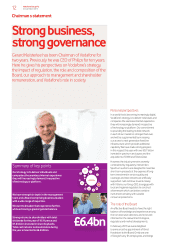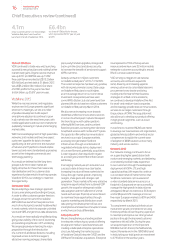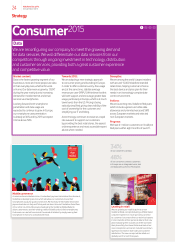Vodafone 2013 Annual Report Download - page 22
Download and view the complete annual report
Please find page 22 of the 2013 Vodafone annual report below. You can navigate through the pages in the report by either clicking on the pages listed below, or by using the keyword search tool below to find specific information within the annual report.
Scale
The mobile industry is a large and important
sector with around six and a half billion
connections, generating over US$960 billion
of annual service revenue every year.
The majority of revenue, some 75%, comes
from traditional services such as calls and texts
(on average, around 17 billion mobile phone
calls are made each day). However, over the
last few years the demand for data services,
such as mobile internet browsing and email
on a smartphone, has accelerated, and today
25% of industry revenue is from data.
Growth
The demand for mobile services continues
to grow. In the last ve years the number
of users has increased by an average of 14%
each year driven by rising living standards,
population growth and cheaper mobile
services and handsets. In 2012 93% of the
world’s population had a mobile phone,
whereas ten years ago this was only 18%. Most
of the growth in users has been from emerging
markets, such as China, India and Africa.
As a result around 73% of mobile phone users
now come from emerging markets compared
to 60% in 2007.
Emerging vs. mature markets
Around 70% of mobile users are in emerging
markets, reecting the combination of large
populations and less xed line infrastructure.
The remaining users are from wealthier
mature markets, such as Europe and the US.
In mature markets, most people have a mobile
device, reected in mobile penetration rates
of around 125%, compared to around 90%
in emerging markets.
Competition
The industry is highly competitive, with many
alternative providers, giving customers a wide
choice of supplier. In each country there are
typically at least four main mobile network
operators, such as Vodafone, and one national
xed line operator. In addition, there can
be numerous mobile virtual network operators
(‘MVNOs’) – suppliers that rent capacity
from mobile operators to on-sell to their
customers. In some countries there can also
be several independent mobile retailers that
may compete with mobile network operators’
own stores. Advances in technology have also
led to internet based companies and software
providers offering alternative communication
services such as voice over internet protocol
(‘VoIP’).
Regulation
The mobile industry is very heavily regulated
by national, regional and international
authorities. Regulators continue to lower the
cost for consumers of using mobile services
by setting lower mobile termination rates
(the fees mobile companies charge for calls
received from other companies’ networks)
and to limit the amount that operators can
charge for mobile roaming services. These
two areas represent 13% of service revenue
for Vodafone.
In an environment of intense competition
and signicant regulatory pressures, industry
voice prices have tended to reduce over time
– and in 20121 fell 12%. However, with more
mobile phone users and some customers
using their devices ever more frequently,
global industry revenue remains on a positive
trend and expanded 4% in 20121.
Where the
industryisnow
The mobile industry is a large and important sector
with around six and a half billion connections across the
globe – in other words, most of the world’s population
use mobile phones. The number of mobile phone users
has doubled in the last ve years, driven by an increasing
range of smartphones for using mobile data, increasing
demand for mobile services in emerging markets and
lower prices.
Industry trends
Mobile phone users by market 2012
US: 5%
Other Asia: 15%
Other
devel-
oped1: 5%
Latin
America: 11%
Other: 5%
China: 17% Europe: 17%
Africa: 11%
India: 14%
1 Japan, Canada, Australia, New Zealand, Hong Kong, Singapore,
South Korea, Taiwan
Note: Figures are not comparable with prior year disclosure due
to new data source
Mobile phone users
2007 3.4bn
6.0bn
6.5bn
2011
2012
Mobile penetration December 2012
Turkey
US
Europe
91%
110%
137%
69%
81%
India
China
Notes:
The industry data on pages 20 and 21 is sourced from
Strategy Analytics.
1 Refers to calendar year.
20 Vodafone Group Plc
Annual Report 2013
























